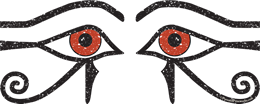Pyramid Printworks Personalized Collection & Custom Cartouche Clothing
UPDATE 11.29.2021: Due to Supply and Technology issues, we are unfortunately not able to fulfill Custom orders at this time. Please follow us on Instagram @pyramidprintworks for updates, and check our Redbubble and Amazon stores for our other great products. We apologize for the disappointment but hope to be back at it soon! THANK YOU!!!
Personalized Egyptian Cartouche T-Shirts & accessories! We were the first to design and offer Personalized Cartouche T-Shirts to the public. Originally created in 1991, and sold via catalog and mail-order since 1992. The Pyramid Printworks Collection is the result of a lifetime of love for the art, language, and culture of Ancient Egypt.
The designs in the Pyramid Printworks Collection are based on Ancient Egyptian paintings and monuments, carefully researched to ensure their historical accuracy and authenticity. We’re dedicated to providing the finest unique products to our growing worldwide family of Egyptophiles! When you buy from us, you become part of our community – you get guaranteed quality, friendly personal service, and a unique piece of art to give and wear!
THE HIEROGLYPHS
The Ancient Egyptian writing carved and painted on monuments, tombs, and temples was called by the Greeks ta hieroglyphica – “the Sacred Carvings.” The Egyptians called hieroglyphic writing “the Divine Words.” Scholars believe that Hieroglyphs began about 3300 BC as pictographs – pictures that meant exactly what they represented. Eventually, the Hieroglyphic writing system consisted of over 700 pictorial and alphabetic signs. The Egyptians wrote names, epithets, and blessings on everything from jewelry and amulets to furniture, garments, and common household objects.
THE NAME
Names were very important to the Ancient Egyptians. Names described the attributes, desires, and godly associations of their owners. A person’s name expressed his or her unique identity on earth and in the afterlife. To speak a person’s name was to make him live – and to write a person’s name in Hieroglyphs was to make him live for all eternity.
THE CARTOUCHE
The name of a royal person was enclosed in an oval “name-ring” called a cartouche. The name-rings were dubbed cartouches by the members of Napoleon’s expedition to Egypt, who thought that they looked like ammunition cartridges. Called shenw – “that which encircles” – by the Egyptians, the cartouche is a stylized double thickness of rope with the ends tied together. Originally a circle representing the sun and its realm, the cartouche was elongated to surround the royal name. This symbolized that the King was ruler of all that the sun encircled.
YOUR PERSONALIZED INSCRIPTION
Your Personalized Inscription includes your Name in a Cartouche, within an Ancient Egyptian Blessing formula in three columns, that reads:
Behold! Your Name shall exist forever!
( Your Name )
Given All Life, Stability, Power, Prosperity and All Health Forever! (Eternally, or Always)
HOW WE TRANSCRIBE MODERN NAMES INTO HIEROGLYPHS
Your Name will be transcribed the Ancient Egyptian way – by the sounds. When the Egyptians encountered names of people from other places, they simply wrote them phonetically – in other words “sound for sound,” not “letter for letter.”
We use modern Egyptology standards and research historical examples to ensure the most authentic and historically accurate phonetic transliteration possible.
Thus, your Name may have more or fewer Hieroglyphic characters than letters in your language, because there are sounds in English and other modern languages that don’t occur in Ancient Egyptian, and the Egyptians rarely wrote the vowels.
Multiple-letter combinations typically only have one sound (nn, er, ou, que, tte, etc) and would be written with one hieroglyph. Some letters (like X) technically have 2 sounds and would be written with two hieroglyphs to match the sound (K and S). And some hieroglyphs represent two or more letters or sounds.
The scientific method we use means that an Ancient Egyptian could read and pronounce your name correctly!
MASCULINE AND FEMININE DESIGNS
The Egyptians differentiated the person being described or addressed as either masculine or feminine, as many languages do. In our Blessing formula, we have followed this tradition. The hieroglyphs indicating gender are the Rope Tether and the Basket with Handle – otherwise they are identical.
During the order process, we will ask which gender you prefer on your shirt. If no gender is specified, the default hieroglyph is the Basket with Handle. (Fun fact: The famous female Pharaoh Hatshepsut was usually referred to in the temple monuments by the masculine gender.)
THE COLLECTION
Each piece in the Pyramid Printworks Collection is a unique work of art, individually custom printed by hand in full glorious colors matched to the ancient monuments. Our intention is to celebrate and honor the ancient artistic traditions and symbols of Kemet, while enjoying them in our modern way. We hope the Ancient Egyptians would appreciate what we’ve created to celebrate their culture and ensure that they will live forever!
Enjoy the beauty of your name written in this ancient and elegant script!
UPDATE 11.29.2021: Due to Supply and Technology issues, we are unfortunately not able to fulfill Custom orders at this time. Please follow us on Instagram @pyramidprintworks for updates, and check our Redbubble and Amazon stores for our other great products. We apologize for the disappointment but hope to be back at it soon! THANK YOU!!!



